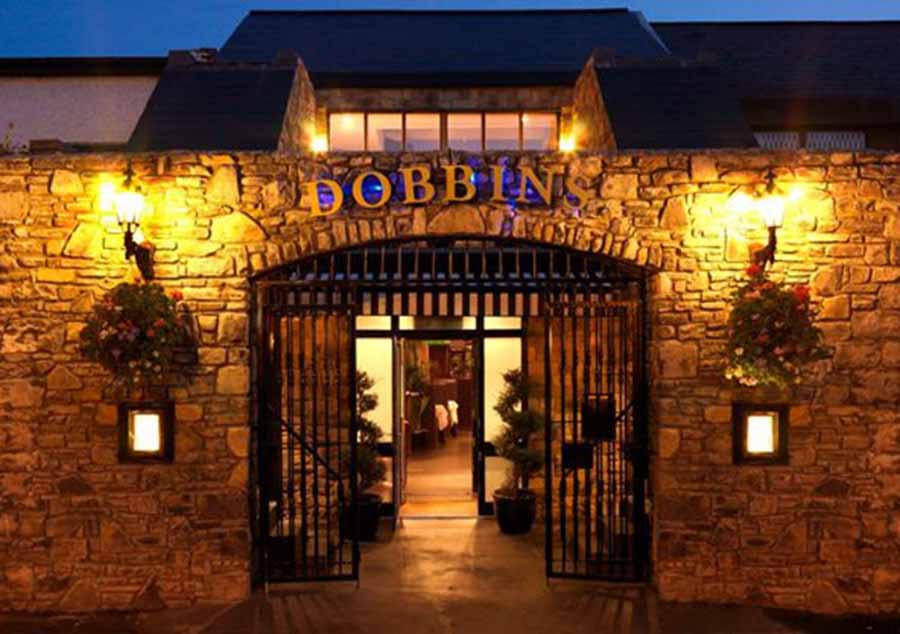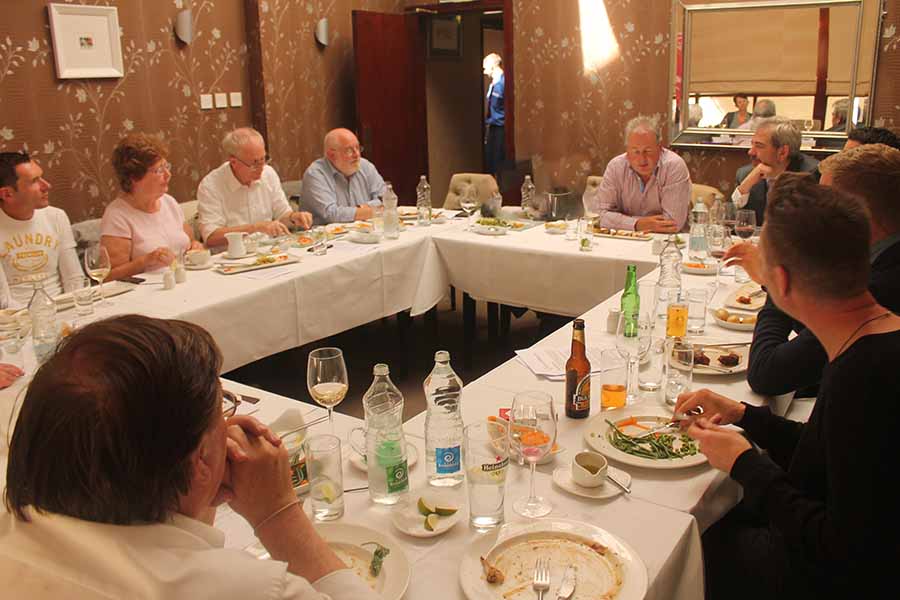
By Eoghan Corry
Most people’s first encounter with Dobbins restaurant (or “Dobbins bistro” at a time when all you had to do to sound chic was say it in French) was trying to find the place.
Located in a back alley in an unfashionable setting off Mount Street, there was no parking, no ambience and practically no saving grace about his chosen site, which suggested “low rent” before the door had been opened.
Not that it mattered when John O’Byrne took hold of the operation. As he said himself: “you lose all time in this Nissan hut.”
In an age when Dublin’s celebrity culture was a baby version of what it is today, John O’Byrne did not have the best restaurant in Dublin, but he certainly knew how to generate publicity.
Mr O’Byrne knew the potential of a celebrity culture. He had seen it when working as a waiter in Jammet’s, where his younger brother Seamus was head waiter. Influencers (before the term was popular) like Eoin “the Pope” O’Mahony and Tomás O’Faoláin (Terry O’Sullivan of Dubliner’s Diary in the Evening Press) were regulars there. It was the place to be seen in Dublin for six decades.
But Jammets, “with its world reputation as a restaurant” closed in 1967, and in the words of Ulick O’Connor “became a self-service joint.”
Theodora Fitzgibbon bemoaned in the aftermath of Jammet’s demise that “the average overpriced Dublin restaurant and people eating poorly cooked food with apparent relish.”
Writing in John Mulcahy’s Hibernia in 1970, food critic Alec Reid yearned for the days when the restaurant was an extension of the home, as “now it has become part of one’s image – you eat the scampi, the steak or whatever is the appropriate executive food in the appropriate pseudo-intimate, half-lit sham panelled utterly unreal surroundings.”
Dobbins seizes the day
With the closure of Jammet’s, Shea O’Byrne emigrated to South Africa and later Canada. While he was there he stumped up the money for a restaurant that might invigorate the Dublin culinary scene. Dobbins opened in 1976. Patrick Walsh took command of the kitchen and Shea’s older brother, John, was given the task of creating a fuss around it. This he did with three ingenious moves.
Firstly, he identified the need to depart from tradition. When nearly all of the restaurants in Dublin were attached to hotels, Dobbins was the first of new breed, a stand-alone restaurant that was informal, offered pretty good food and was affordable.
Secondly, he calculated that the action would be at lunch time. A Nissan hut on Stephen’s Lane was not likely to rank among Dublin’s most romantic evening dinner locations. The Dobbins clientele could be tempted in for lunch and, if they enjoyed it, might be tempted to stay for the afternoon and quaff expensive wine where serious real mark-up could be achieved.
Thirdly, he turned his attention to greeting, not feeding. Mr O’Byrne (“John” or “Johnny” to his friend, and everyone who graced the restaurant was a friend) focussed on meeting and greeting guests. While he claimed to know all about cooking and haute cuisine, the diners were not immensely attentive. Dublin did not really have an inner circle in the manner of other European capitals, so John O’Byrne created one.
Food was good, if predictable, and affordable, and Dobbins sticky toffee pudding became a celebrity dish in its own right. As fine dining goes, Dobbins would not have made or sustained a reputation today or indeed anywhere else in 1970s Europe.
Not that it not mattered. Dobbins worked off a different menu from the others arriving on the scene seeking inspectorate accolades to put on their walls like Patrick Guilbaud, Colin O’Daly, Kevin Thornton and Alan O’Reilly.
Most of all, he was a power house of publicity. The evening newspaper diarists John Feeney and Tomás Ó Faoláin were always welcome, as were Trevor Danker, Jim Farrelly, Angela Phelan and what was known as the chattering class, in a borrowed buzzword of the time. As the mentions accrued, so did the celebrity diners.
Dobbins customers were more interested in politics than palates. If the Provençale was juicy, the jus de gossip was even more so.
Venue of choice
By the mid 1980s Dobbins had become the venue of choice for business lunches, attracting businessmen, lawyers, the celebrities of the city (not many in those days), wannabe celebrities (a lot) and notice boxes (even more). Thanks to Mr O’Byrne’s personality and contacts. it hosted launches and press conferences. The waitress and cafe scenes in the movie Educating Rita were filmed there in 1982.
Charles Haughey, Albert Reynolds, John Bruton and Bertie Ahern were regularly spotted there. Mary Harney had a personal table. Gay Byrne launched his biography there.
Mr O’Byrne claimed to have personal notes from Bill Clinton and Francois Mitterand (could we believe him? it was likely he had).
Mr O’Byrne flaunted his celebrity connections, his access to theatre and match tickets. He was one of the city’s chief custodians of gossip and a client list that included visiting premiership soccer players. models, entrepreneurs, and legal professionals.
Long, lingering lunches
Long, lingering lunches became the stock in trade of the restaurant. Mr O’Byrne would join your table, throw in some gossip and stay for a chat, an engaging, interesting and interested conversant,
He would even mention a new fine wine he had in stock and show it on the menu.
He might even order a bottle, savour its opening, taste it and then pass to the next table.
“How generous,” you might think.
It was only when the evening had passed and it was time to leave that you found it had been added to the bill.
Needs must. Ireland was in the middle of a recession in the 1980s. John O’Byrne survived.
Others did not.
John O’Byrne died in 2003. Dobbins ceased trading in 2016 and was recently sold to Colm Wu for €850,000
Dobbins menu starters
- Dobbins Daily Soup
- Fresh Castletownbere cab pickled cucumber, celeriac remoulade
- Home smoked chicken and pear salad parmesan, semi dried cranberries, caesar, dressing
- Pressed terrine of ham hock and confit chicken, piccalilli of vegetables, toasted brioche
- Lightly poached & smoked salmon pickled beetroot, horseradish cream
- Fresh prawn salad, crispy iceberg lettuce, marie rose sauce
- Crispy FRIED GOATS CHEESE, mixed salad leaves, basil pesto, balsamic reduction
- Spring roll of confit duck stir fry noodles, hoi sin sauce
Starters a la Carte
- Tempura of prawns, mixed leaf, bell pepper and coriander salsa
- Lightly poached & smoked salmon pickled beetroot, horseradish cream
- Fresh Castletownbere crab pickled cucumber, celeriac remoulade
- Pressed terrine of ham hock, confit chicken
- piccalilli of vegetables, toasted brioche
- Crispy fried goats cheese
- mixed salad leaves, basil pesto, balsamic reduction
- Smoked chicken & pear salad parmesan, semi dried cranberries, caesar dressing
- Spring roll of confit duck
- Stir fried noodles, hoi sin sauce
Main Course set menu
- Breast of free range chicken cassoulet of beans, toulouse sausage & veal jus
- Aged rib-eye of Hereford Beef, creamy champ potato, brandy & green peppered sauce
- Boned aromatic Peking duck star anise, orange jus
- Crispy tempura of fresh haddock, creamy tartare sauce
- Roast fillet of Atlantic hake crispy bacon and potato, baby capers, bouillabaisse sauce
- Slow cooked belly of pork Clonakilty white pudding, turnip puree, crispy crackling, honey and soya glaze
- Roast rump of Slaney Valley lamb potato croquette, ratatouille vegetables rosemary jus
Main course a la carte
- Aged Rib-Eye of Hereford Beef, creamy champ potato, brandy & green peppercorn sauce
- Boned Aromatic Peking duck star anise & orange jus
- Breast of free range chicken cassoulet of beans, toulouse sausage & veal jus
- Pan Fried monkfish, sauté spinach, ravioli of prawns, boulabaise sauce
- Roast Rump of Slaney Valley lamb potato croquette, spinach puree, rosemary jus
- Slow cooked belly of pork, Clonakilty white pudding, turnip puree, crispy crackling, honey and soya glaze
- Roast Fillet of Atlantic hake, crispy bacon and potato, baby capers, bouillabaisse, sauce
Note on the menu: All our Food is Irish Produced and Supplied




